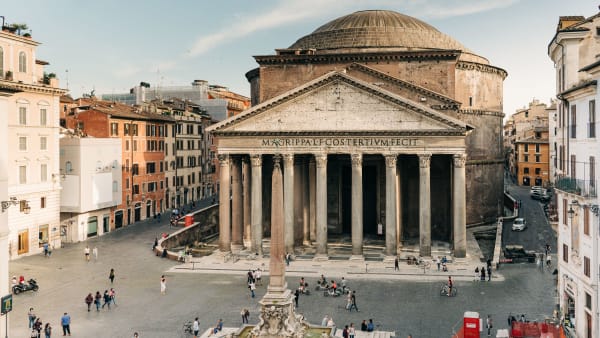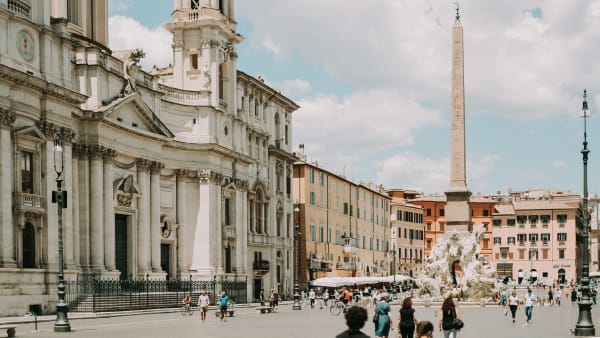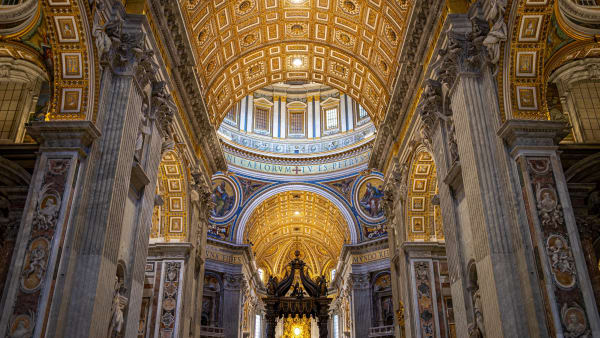Nearby places of interest
Nearby places of interest
The Monument to Victor Emmanuel II is located in Piazza Venezia. Thanks to its central position in Rome it is very easy to reach, either by public transportation , by cab or by foot.
By metro
The Vittoriano isn’t far from the stop Colosseo on metro line B. Once you reach the metro exit, you will only need to follow Via dei Fori Imperiali for 950 meters (12 minutes on foot), and you’ll reach Piazza Venezia, with the Vittoriano on your left.
A single ticket (B.I.T.) costs € 1.50, but the metro also offers tickets for 24, 48, or 72 hours or even for a week.
See more info about the Rome metro.
See details on tickets and subscriptions for public transportation in Rome.
By tram
As for the tram, the best option is Piazza Venezia, on line 8 of the Tram Line. Once you arrive at the stop, you’ll find yourself in front of Piazza San Marco, with the Vittoriano to your right.
Rome’s tram network also uses the 1.50 euro single-ride BIT tickets, as well as other available passes.
See more info about the streetcar in Rome.
See details on tickets and subscriptions for public transportation in Rome.
By bus
This is the means of transportation that offers the most options. The buses in Rome allow you to reach Piazza Venezia with several lines. The ones here indicated stop right in front or to the side of the Vittoriano.
| Line |
|---|
| Closest stop |
| Itinerary |
| Line | 119 | 85 | 70 | 628 | 51 | 118 | 83 | 160 | 63 | 40 | 64 | 60 | 80 |
|---|---|---|---|---|---|---|---|---|---|---|---|---|---|
| Closest stop | Venezia | Piazza Venezia | Piazza Venezia | Piazza Venezia | Piazza Venezia | Piazza Venezia | Piazza Venezia | Piazza Venezia | Piazza Venezia | Piazza Venezia | Piazza Venezia | Piazza Venezia | Piazza Venezia |
| Itinerary | An almost circular route, starting from Piazza Venezia, going around Piazza del Popolo, and then back to the terminal. | It links the Termini area to Piazza Venezia and the Colosseum. It extends to the southeast of Rome, to areas of little tourist interest. | It travels a short distance in the center of Rome, from stops Clodio to Giolitti | It links two areas to the north and south of Rome, passing through the center and following the course of the Tiber for a stretch. | It links the San Giovanni metro station to an area close to the Trevi Fountain, via Piazza Venezia. | Useful for visiting places of interest such as the Colosseum, Piazza Venezia, Circus Maximus, the Roman Forum, and even the Baths of Caracalla. | It connects two areas outside the center of Rome, from north-east to south, passing through the center and stopping at Piazza Venezia. | It crosses Rome from north to south, linking Villa Borghese with Montagnola, and stopping at Piazza Venezia | Collega una zona esterna, nel nord-est di Roma con il centro, facendo capolinea in prossimità dell’Isola Tiberina. | It connects Termini Station with Castel Sant’Angelo, stopping at key points in the center such as Piazza Venezia and Largo di Torre Argentina. | It connects Termini Station with the Vatican, crossing the center of Rome on the way. | This line connects an area in the northeast of Rome with the center, terminating at Piazza Venezia. | It links a peripheral area, north of Rome, with the city center, terminating at Piazza Venezia. |
The city buses use the same tickets that are also valid for the metro, trams, and suburban trains. The cost of a single bus ticket is therefore always €1.50 (BIT) and is valid for all other means of public transportation.
Find more info about buses in Rome.
See details about tickets and subscriptions for public transportation in Rome.
By taxi
Cabs are obviously the most comfortable option, but they are also the most expensive and are not guaranteed to be the fastest way to get to Piazza Venezia due to the heavy traffic in the central area of Rome.
However, this means of transport is a good option if you feel like chatting with a cab driver, who can tell you a few secrets of the city or entertain you with his typical Roman humor.
The best way to get a cab in Rome is to book it by phone, mobile apps, or simply by going to a cab stand. For instance, there is a cab stand along the east side of Piazza Venezia.
By foot
Walking is undoubtedly the option that ensures you enjoy the monumental beauty of the Eternal City to the fullest. Fortunately, the Vittoriano in Piazza Venezia is close to many other interesting sites.
You could, for example, consider taking a walk to visit the various monuments belonging to the Renaissance-Baroque-Rococo period in Rome. Some of the stops could be the Vittoriano, Venice Palace, Piazza Navona, Sant Angelo’s Bridge and Castle, the Spanish Steps, and the Trevi Fountain.
Nearby places of interest
The Vittoriano is, as mentioned, surrounded by other attractions and in an excellent location compared to the main streets of Rome. Here’s a list of sights that you can visit within walking distance of it.
Piazza Venezia
Piazza Venezia with the Altare della Patria is among the iconic sights of Rome. It’s located at the foot of Campidoglio hill, where five of the city’s main streets intersect. It’s named after the nearby Palazzo Venezia, which was used as the embassy of the Venetian Republic in Rome.
A few sights in this square include Palazzo Bonaparte, the Monument to Victor Emanuel II, Palazzo Venezia, Basilica San Marco, and the bust of Madame Lucrezia.
The Vittoriano is at the southern end of Piazza Venezia.
Colosseum
The Flavian Amphitheater is the most important symbol of Italy and therefore definitely worth a visit during your stay in Rome. Each year, about six million travelers visit the ruins of the Colosseum, which are among the new seven world wonders.
Admission to the Roman Forum, the Colosseum, and the Palatine is included in a single ticket .
The Colosseum is located 850 metres south of Piazza Venezia and the Vittoriano.
Palatine Hill
The Palatine is one of the seven hills of Rome and the first that was inhabited. Since the imperial period, it was the hill where the emperors built their palaces.
Here you can visit, among others, the remains of the residences of the House of Augustus, the Domus Tiberiana, the House of Livia, the Domus Aurea, the Farnesian Gardens, the Domus Transitoria, and the Hut of Romulus.
The entrance of the Palatine is located 1,3 km from the Vittoriano(a 16-minute walk).
Arch of Constantine
Among the three arches of triumph that still exist in Rome, this is the best-preserved one. The striking monument was built in the early fourth century to commemorate the victory of Constantine I at the Battle of Milvian Bridge in 312 AD.
It’s the last great monument of Imperial Rome and was inaugurated on the 10th anniversary of Constantine’s reign. It’s an imposing 21 meters high and 25.6 m wide and stood on Rome’s triumphal route.
The Arch of Constantine is 1 km from the Vittoriano (a 12-minute walk).
Imperial Fora
The Fori Imperiali consists of a series of monumental fora (public squares). They were built over a total period of 150 years, between 46 BC and 113 AD. Over the years, Caesar, Vespasian, Augustus, Nerva, and Trajan contributed to its development.
The Imperial Fora were built to replace the Roman Forum after it became too small due to strong population growth and could no longer fulfill its purpose as the center of Rome.
The entrance to the Imperial Fora is 110 meters south of Piazza Venezia and the Vittoriano.
Circus Maximus
Considered to be the largest sports stadium built by man, this archaeological area was the site of legendary entertainment activities for nearly a thousand years.
Most of the building is underground and there’s not much left to see above ground. However, through a virtual reality tour , you can discover what the circus used to look like. It’s definitely worth a visit.
The entrance to the Circus Maximus is located 800 meters southeast of Piazza Venezia and the Vittoriano (a 10-minute walk).
Domus Aurea
The remains of the great palace that Emperor Nero ordered to be built in 64 AD can be visited in a virtual reality experience tour .
The VR glasses allow you to explore Nero’s extravagant residence in all its glory and get an idea of what it would have looked like at the time.
The entrance to the Domus Area is 1 km east of the Vittoriano (a 14-minute walk).
Ludus Magnus
The Ludus Magnus was the largest of the four Ludi (gladiatorial schools) known from ancient Rome. The rectangular building complex was commissioned by Emperor Domitian (81-96) and completed by Hadrian (117-138).
The building was located in the valley between the Caelius and the Esquiline, east of the Colosseum—to which it was connected by a subterranean passage.
The Ludus Magnus is 1,3 km east of Piazza Venezia and the Vittoriano (a 16-minute walk).
Basilica of San Clemente
This intriguing building complex is a Roman Catholic church dedicated to Pope Clement I. The first tier was built in the fourth century, making it one of the oldest Christian churches in Rome.
Over the centuries, three successive floors have been built over it, of which the top three can be visited. During a visit, you can admire (among other things) the underground temple of the Persian sun-god Mithras and numerous medieval frescoes.
The Basilica of San Clemente is 1,5 m from the Vittoriano (19-minute walk).















